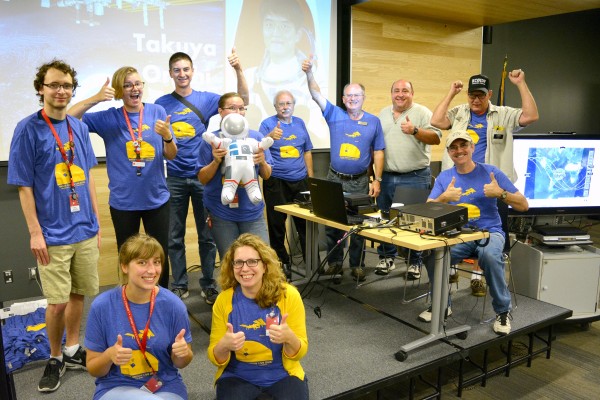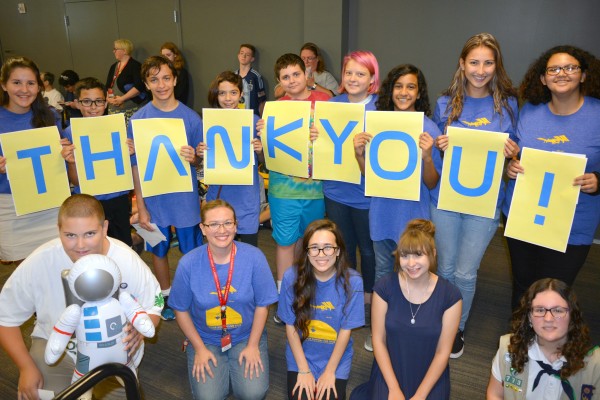Hello, Space Station! Teens Chat with an Astronaut via Ham Radio
Through a NASA educational program, a Kansas teen librarian developed a related STEM curriculum that culminated in radio contact with the International Space Station.

A member of the Douglas County (KS) Amateur Radio Club holds the microphone for a student.
For two terrifying minutes, I stood before some 300 library patrons while members of the Douglas County (KS) Amateur Radio Club (DCAR) tried to hail the International Space Station (ISS). Finally, the voice of astronaut Takuya Onishi crackled back a response to our exhilarated crowd. The teens who had arranged contact with the ISS began radioing in questions. Our journey to this extraordinary moment began when I found out about the Amateur Radio on the International Space Station (ARISS) program. In collaboration with NASA, ARISS facilitates radio contact with the ISS and gives students a unique chance to apply their STEM studies to an amazing, real-life experience. It also places careers in space exploration at the forefront of their imaginations. To kickstart our process, I explored ARISS.org and ARRL.org (Amateur Radio Relay League), read the application, and checked out the resources. ARISS allows groups with all levels of resources to participate in the program. The application process takes time, but is well worth it. It includes creating a related educational program, drawing up an equipment plan, and establishing a contact day and time. The first stage of the application—the education plan—is a chance to look for engaging programs that connect to experiments being done on the ISS, in the U.S. space program, or STEM fields in general. The websites provide links to K–12 lesson plans and other resources from NASA and past participants. Local science museums, colleges, and clubs may also have related research they would be willing to present at your library. Our educational plan for teens included creating container gardens to grow plants being studied on the ISS; earning our radio technician licenses; and meeting with our local astronomy club to watch the transit of Mercury. While programming is an important part of your educational plan, you will also be asked to describe how you will market the event, select questions for the astronauts, and envision the day of the contact happening. While many of our programs were low cost, we held one technical program that was fairly expensive: building individual crystal radios. The kits we used cost about $15 each, and thanks to a grant from our local U.S. Bank, each participant was able to build their own.
Library staff and members of the Douglas County Amateur Radio Club celebrate successful contact with the International Space Station.
ARRL can help you to locate and contact the nearest amateur club, which must file the application with you. Be prepared to give the club a presentation about your plans, what they’ll get out of it, and what will be required of them. You’ll be relying on their expertise to make contact, so it’s important to build a good relationship. I had a wonderful time getting to know our local club members and was constantly amazed by the breadth of their skills and knowledge. After your educational plan has been approved, your local radio club will take the lead in creating your equipment plan (stage 2 of the application). ARISS then assigns a mentor to help you through this process. The major decision that will need to be made is between two types of contact: a Telebridge or a Direct Contact. A Telebridge contact requires very little equipment or cost. Your kids or teens are patched in via phone to a radio connection that has been made somewhere else in the world. This can add an interesting element to the contact, in that you may be speaking to someone on the other side of the globe. A Direct Contact means that you connect directly to the ISS from a radio installed at your location. This was our choice at the Lawrence Public Library. Our local radio club members had most of the equipment we needed and and borrowed or built almost all of the additional items. The club did make some purchases but wouldn’t allow us to reimburse them, as club members planned to use the items in the future. Once your educational and equipment plans have been approved, the last step is waiting for an assigned contact date and exact time. You will be given a general idea of when this will be several months in advance but won’t know the specifics until a week before your contact. Flexibility is key.Making contact
Finally, we learned that our contact would happen on September 9 at 11:25 a.m. We asked community members to submit questions and invited local museums, radio clubs, and maker spaces to set up space-related info tables at the library an hour before contact time. At 11:25, the ISS cleared the horizon above Lawrence, KS, and the DCAR folks hailed the ISS. While we waited to connect, our emotions swung wildly from anticipation to despair to total elation. A thrilled teen who had earned his radio technician license with us, and led a sci-fi book club, had the honor of asking the first question. We asked about a dozen questions before the space station passed out of range. These included:- Can you see space junk outside the space station and does it look like litter?
- Have you seen any examples of your crew developing its own space culture?
- Do you have a favorite experiment you’re working on?
- Would you go to Mars if you were given the opportunity?

Participating teens broadcast their thanks to ARISS, NASA, and astronaut Takuya Onishi.
Tips for a smooth connection
- Make sure you have support from administrators and coworkers before you apply. You will need their help to keep on top of all the details.
- Become good friends with your local radio club. You will have to leave some elements of the contact completely in their hands.
- Be honest about contact times that will work for you in your application. For several harrowing days, we thought our contact was going to land at 4 a.m.!
- Our radio connection with the ISS was not completely clear, and some of the responses were difficult to understand. Prepare your crowd to be absolutely quiet during the contact to ensure they’ll hear as much as possible. If possible, set up a strong PA system to help the crowd hear both the questions and answers.
- Rehearse with the kids or teens who will be asking questions. They’ll be less nervous and your contact will run more smoothly.
RELATED
RECOMMENDED
CAREERS
The job outlook in 2030: Librarians will be in demand
CAREERS
The job outlook in 2030: Librarians will be in demand
ALREADY A SUBSCRIBER? LOG IN
We are currently offering this content for free. Sign up now to activate your personal profile, where you can save articles for future viewing






Add Comment :-
Be the first reader to comment.
Comment Policy:
Comment should not be empty !!!